
2020 MFS Global Retirement Survey
Understanding Behavior and Thinking
-
Retirement Confidence
Retirement Confidence
Participants and members are confident in their investing abilities. Based on our survey data, participants and members across all regions feel confident as investors. In fact, 45% of participants and members globally have the confidence to make their own investment decisions.1 However, a deeper dive into the topic raised some red flags.

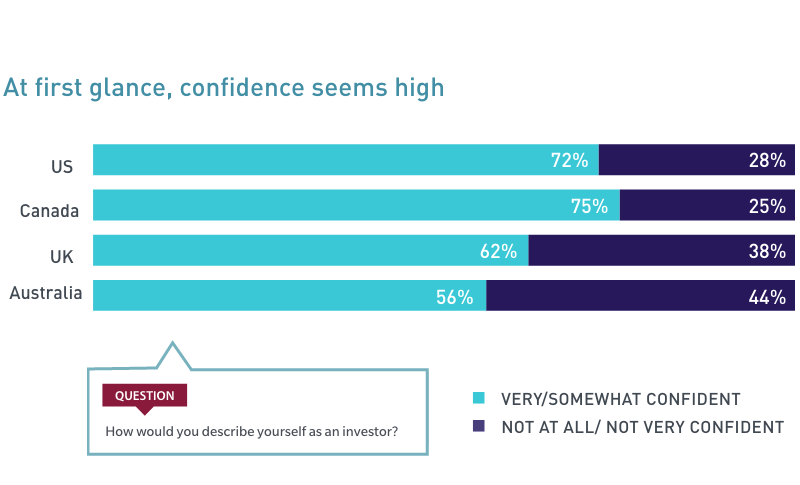
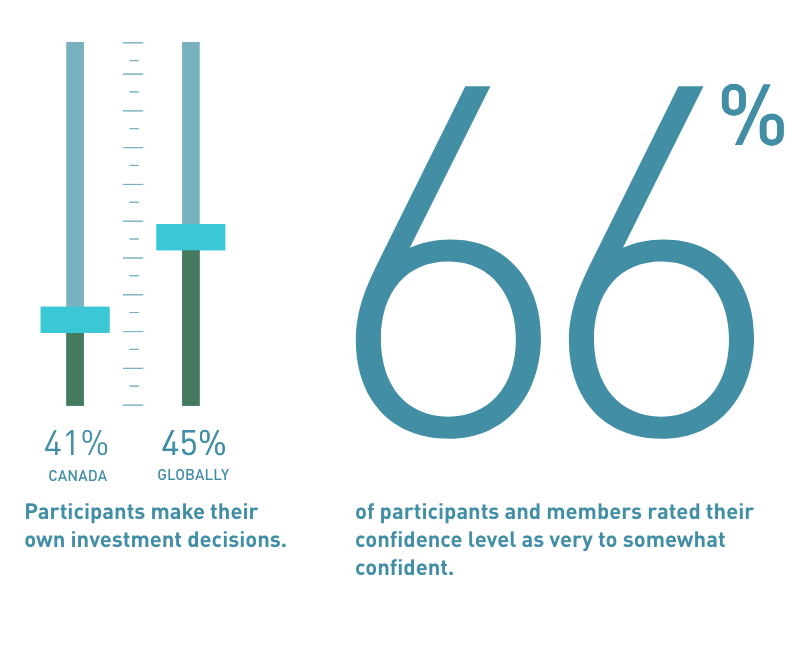
Concerns About Retirement Suggest False Confidence
Participants and members are concerned about having sufficient assets for the duration of their retirement, likely as a result of longevity risk, under-saving and the impact of market volatility. Given these concerns, we feel that retirement confidence could be overstated, and this suggests that many participants and members could be making inappropriate fund selection and asset allocation decisions, resulting in less than optimal outcomes. While working with a financial advisor or planner is more prevalent in the US and Canada, participants and members need more assistance when making investment and retirement planning decisions. Education and guidance can help, and employers can play an important role. UK and Australian sponsors have become more involved in educating their members. And the data show that members are looking to their employers for help.

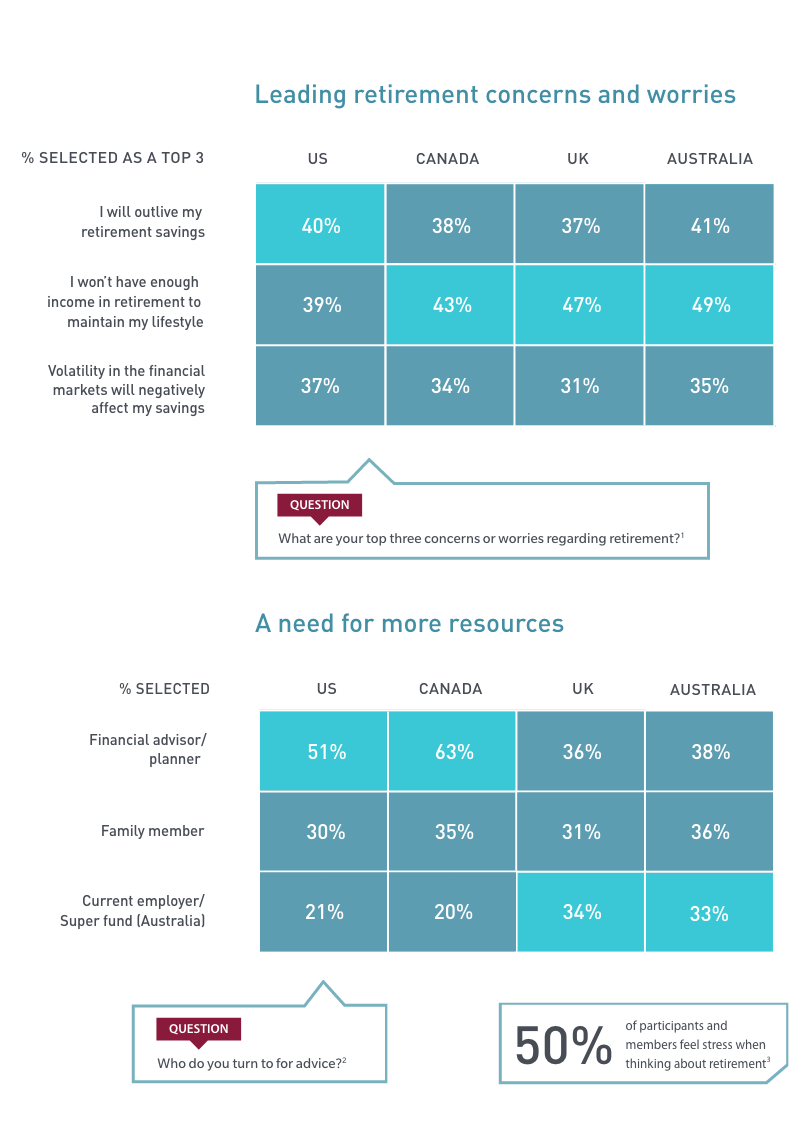
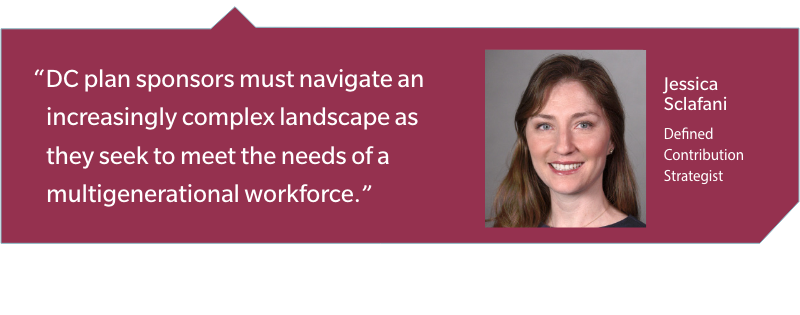
Actions to Consider
Plan sponsors should consider how the resources they provide align with the needs of their participants or members. Education and guidance should be easy to understand and address key concepts.
In addition to education, plan sponsors should think about tactics to help participants and members select appropriate funds. Plan sponsors, advisors and consultants should also consider the importance of working with asset managers that partner with them and their advisors and consultants.Footnotes:
1 Which statement best describes your approach to investing?
2 What resources do you use to help make investment and/or retirement planning decisions?
3 Please indicate the extent to which you agree or disagree with each of the statements about retirement. Thinking about retirement…Related Insights
PDFParticipant Behavior in Volatile Markets: Case study 35 year old
February 1, 2023Hypothetical example of a 35 year old participant and how their actions during the GFC affected their retirement accounts.PDFParticipant Behavior in Volatile Markets: Case study 55 year old
February 1, 2023Hypothetical example of a 55 year old participant and how their actions during the GFC affected their retirement accounts.Volatility Resources10 Priniciples of Long-Term Investing Resilience
March 4, 2022These investor approved pieces walk clients through the fundamentals of investing to help keep them calm and aligned with their goals during times of market volatility.2020 MFS® Global Retirement Survey
The Road to Better Outcomes - Understanding Behavior and Thinking
-
Plan default strategies
Plan Default Strategies
Within the US, Canada and the UK, the majority of participants and members utilize their default options. Target date funds (TDFs) are widely used in the US and Canada as default options. The good news is that participants and members in the US and Canada find that TDFs and default options offer easy diversification, and they understand the basic design of these options. However, UK members are slightly less confident in how default options are managed, suggesting more work may need to be done by UK schemes.
While the Basic Understanding of TDF/Default Structure Is Sound . . . Fundamental Misconceptions Abound
Overall, participants and members have a good understanding of how these options work — shifting from capital appreciation to capital preservation as the retirement savings journey progresses. However, a closer look reveals fundamental misconceptions that are cause for concern. For instance, while participants and members generally understand how these strategies get less risky as they near retirement, they think the strategies provide income or return guarantees. These misunderstandings are of greatest concern for those approaching retirement and for whom risk exposure and retirement income are top of mind.

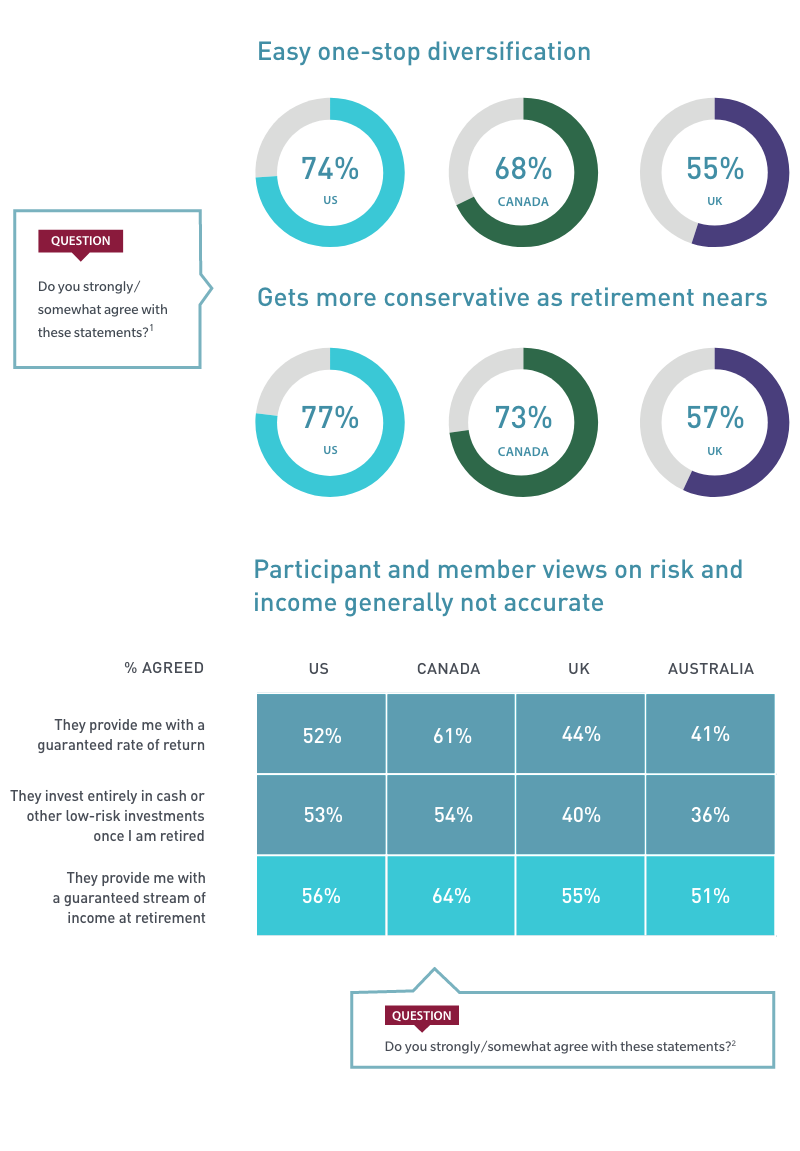
Footnotes:
1 US/Canadian respondents who use TDFs or UK respondents invested in default fund. Please indicate the extent to which you agree or disagree with each of the statements below about target-date funds or UK “default funds” Select one response for each answer.
2 US/Canadian respondents who use TDFs or UK respondents invested in default fund/all Australian respondents. Please indicate the extent to which you agree or disagree with each of the statements below about target date funds/UK “default funds”/Australian “default options”. The default option is the My Super Account option which your super contributions will be paid into if you do not select a super fund.” Select one response for each answer
Path of Least Resistance Works
Today, many plans auto-enroll new participants and members into qualified default investments. The design of default options as a one-stop solution clearly resonates with participants and members.

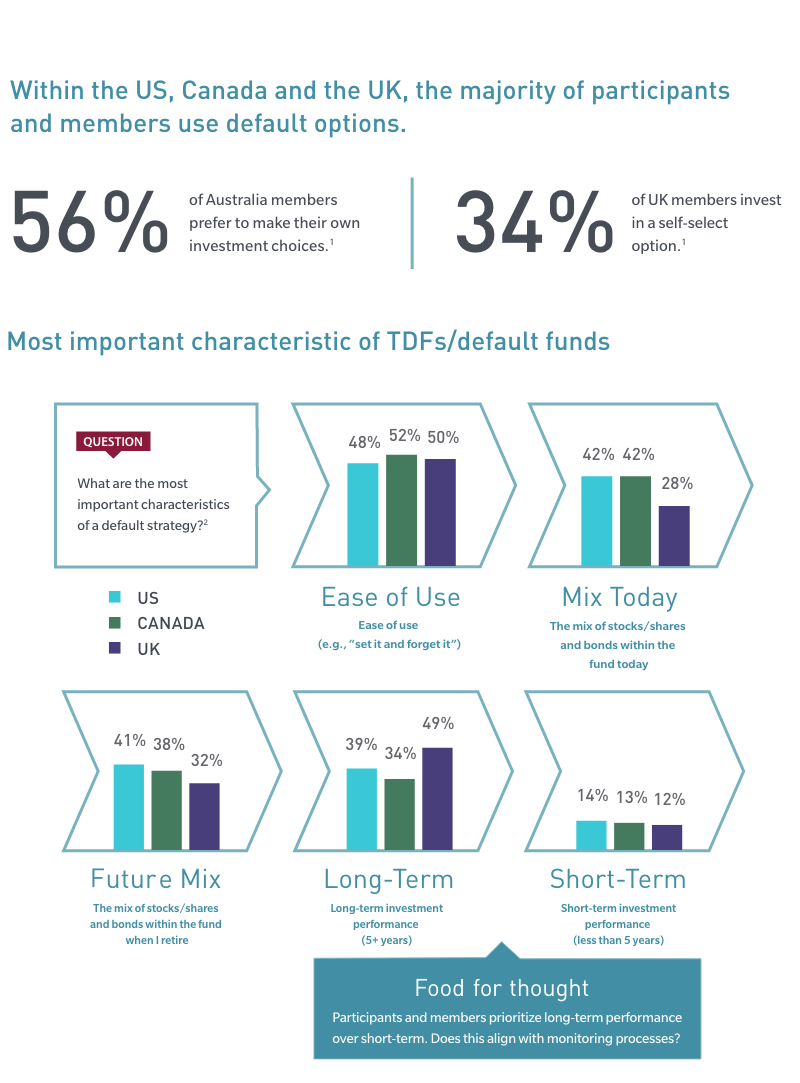
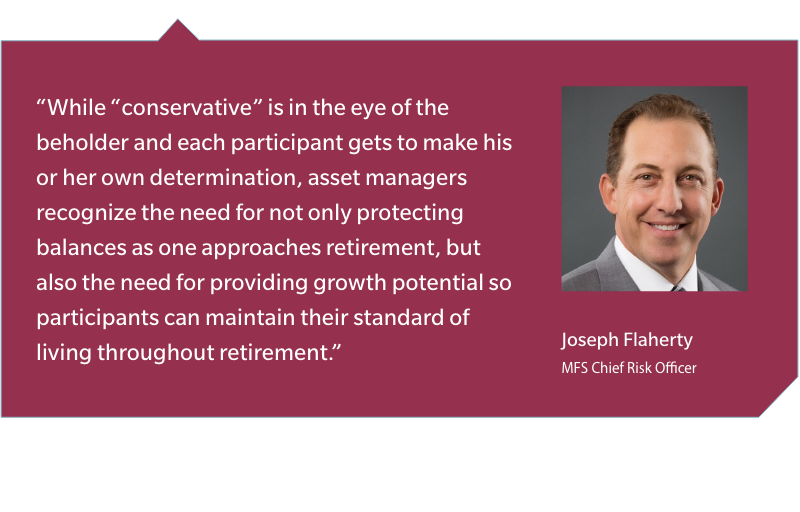
Actions to Consider
Participants and members understand that diversification is essential. We urge plan sponsors, advisors and consultants to explore the diversification of their default strategies at the asset class and sub-asset class level by geography, capitalization, style, credit quality, interest rate sensitivity and investment process. Moreover, they should understand how diversification aligns with participant and member objectives during the savings journey.
Footnotes:
1 [UK respondents invested in default fund / All Australian respondents] Please indicate the extent to which you agree or disagree with each of the statements below about [UK “default funds”/AUS “default options]. The default option is the My Super Account option which your super contributions will be paid into if you do not select a super fund. Select one response for each answer.
2 [Respondents who use TDFs/default funds] What are the most important characteristics of a target-date fund? Please rank order the top five characteristics that are most important to you.Related Insights
2020 MFS® Global Retirement Survey
The Road to Better Outcomes - Understanding Behavior and Thinking
-
Sustainable Investing
Sustainable Investing
Across all regions, there is demand for using a retirement account to address sustainability — often referred to as environmental, social or governance or ESG — issues. However, plan sponsors face some challenges when adding plan and scheme options. Globally, participants and members are highly interested in sustainable investing as part of their retirement plans.

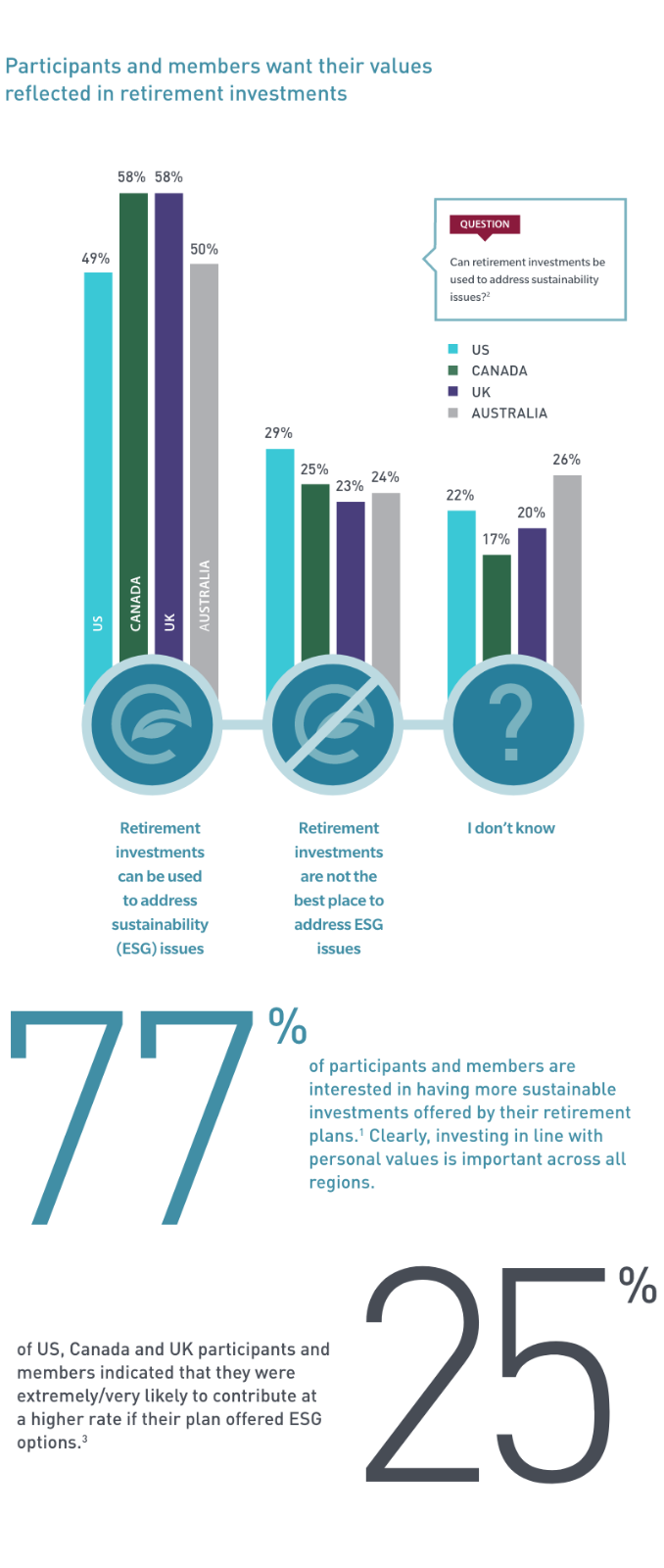
Footnotes:
Please keep in mind that a sustainable investing approach does not guarantee positive results.
1 How interested are you in seeing more sustainable (ESG) investments offered in your [US, CDN “employer-sponsored retirement plan?”/AUS “super fund?”/UK “pension scheme?”]
2 What do you think is the best way to address sustainability (ESG) issues through your [US, CDN “retirement investments?”/AUS “super?”/UK “pension scheme”].
3 How likely would you be to contribute at a higher rate to your workplace fund/scheme if your plan offered or included investment options that consider sustainability issues.Adoption of Sustainable Investing Around the Globe
Regulatory regimes in each country have been key drivers in supporting or discouraging the incorporation of sustainable investments in retirement plans and schemes. Plan sponsors in Canada and the US are generally in the early stages of incorporating sustainable investments into the plan menu, while sustainable investing is more mature and prevalent in the UK and Australia. Despite varying adoption rates around the world, participants and members are consistently supportive, and we expect that participant and member demand for sustainable investments will continue to increase over time.

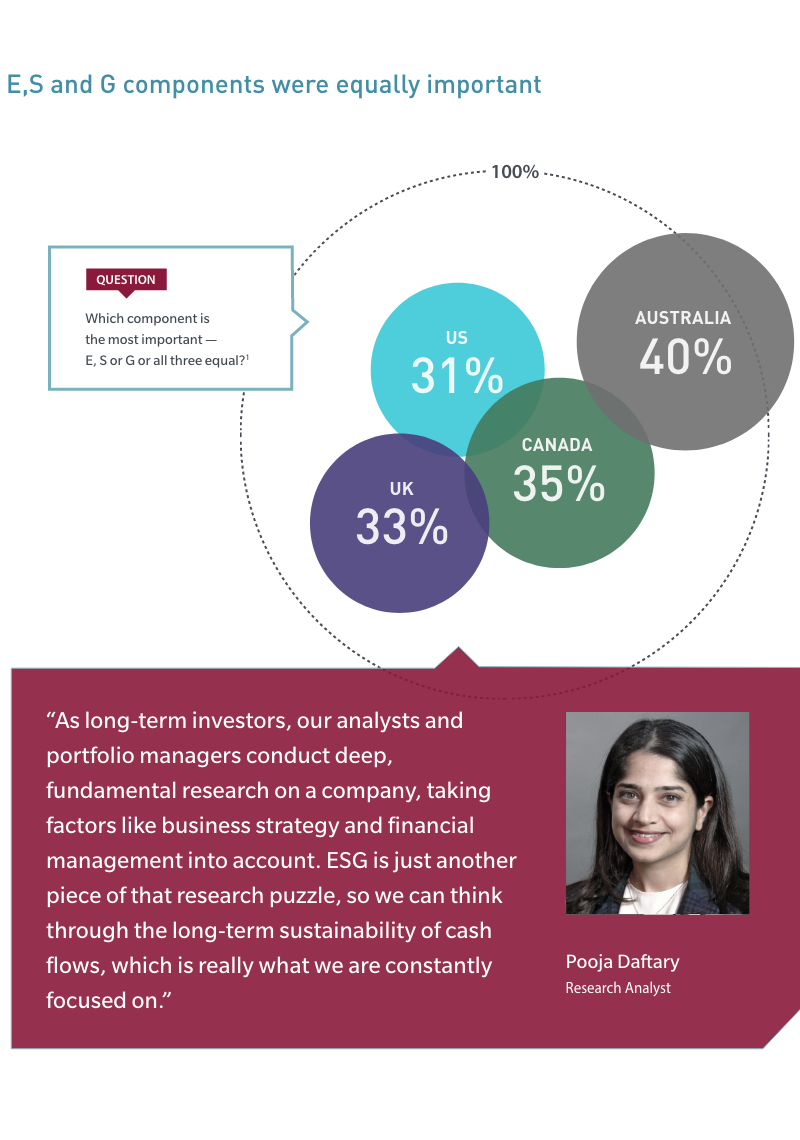
Actions to Consider
There are many ways for retirement plans and schemes to implement sustainable investing. Sponsors should help participants and members understand how sustainability is addressed in the plan or scheme menu. In general, there are two paths when adding sustainable options to a lineup:
- Adding ESG-themed funds to the investment menu
- Working with an active asset manager that integrates the analysis of ESG factors into the investment process
MFS' integrated approach to sustainability considers material risks and opportunities — including ESG factors — as part of our investment decision-making process.
Footnotes:
1 Thinking about your personal values, which in your opinion is the most important component of sustainable (ESG) investing? Please choose one.
Related Insights
2020 MFS® Global Retirement Survey
The Road to Better Outcomes - Understanding Behavior and Thinking
-
Active Management
Active Management
Globally, participants and members lack a solid understanding of active management and the role it can potentially play in helping them achieve better retirement outcomes. This lack of knowledge may further complicate a plan sponsor’s role as a fiduciary. A poor understanding of active management, coupled with a potential low-return environment, places a higher burden on fiduciaries to help participants and members achieve their retirement goals.
Weak Grasp of Active Management Impacts Retirement Outcomes Image
When asked about their knowledge, only 19% of participants and members on average rated their level of understanding as very or somewhat knowledgeable.1

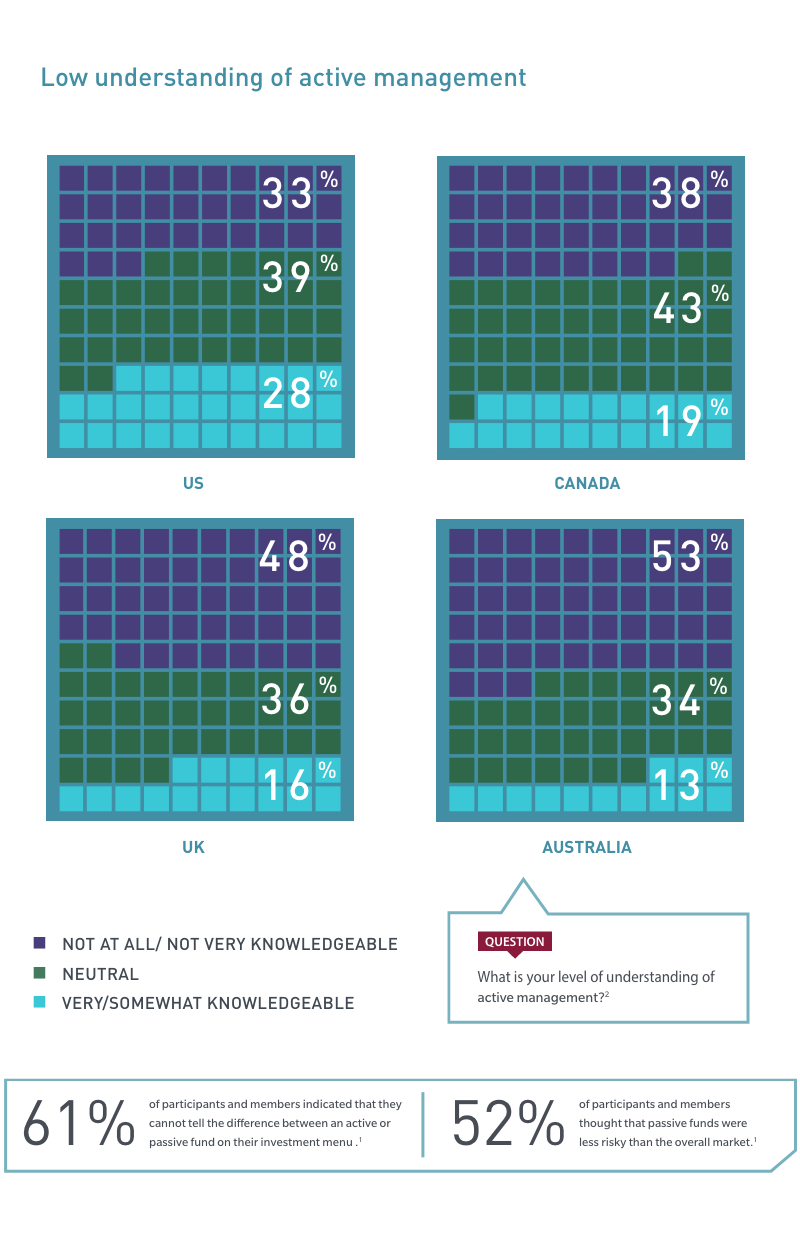
Footnotes:
1 There are different opinions and philosophies on how to invest and we are interested in understanding your perspective. Please give us your opinion on the following statements.
2 How would you describe your level of understanding of the term “active management” related to investing?Cost and Performance Don’t Always Drive Participant and Member Decisions
Our survey data also explored how participants weigh cost and performance when selecting funds. Globally only 25% of participants and members always pick the lower-cost fund, while 33% always choose the best-performing fund. These data call into question the argument that participant preferences are a key factor in driving retirement assets toward passive investments.

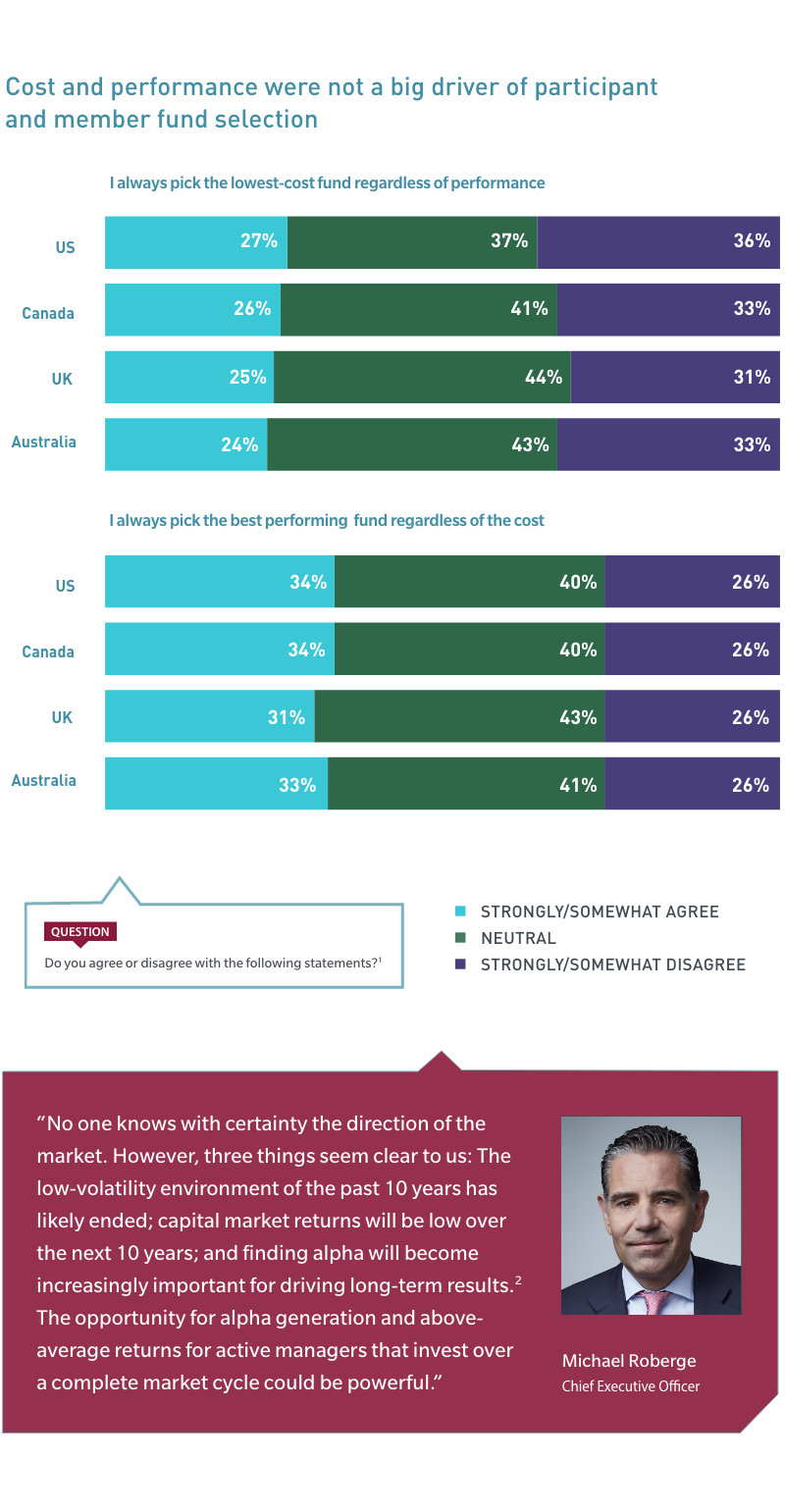
Actions to Consider
Sponsors are asking participants and members to make decisions they are not equipped to make. Unfortunately, the problem cannot be solved by simply providing more education. Fiduciaries need to make decisions that are in the best financial interests of plan participants and members. This puts the onus on fiduciaries to consider constructing a lineup that
- is geared toward the knowledge of participants and members
- considers the needs of their plan demographics
- provides the best chance of delivering beneficial outcomes at a reasonable cost
We believe that following a prudent fiduciary process in the selection of actively managed strategies can aid plan participants and members in achieving their retirement goals while also offering them an opportunity to access sustainable investments through an integrated approach.
Footnotes:
1 There are different opinions and philosophies on how to invest and we are interested in understanding your perspective. Please give us your opinion on the following statements.
2 September 2020, MFS White Paper - Building Long-Term Sustainable Outcomes for clientsRelated Insights
2020 MFS® Global Retirement Survey
The Road to Better Outcomes - Understanding Behavior and Thinking
47379.1
Retirement Confidence
Participants and members are confident in their investing abilities. Based on our survey data, participants and members across all regions feel confident as investors. In fact, 45% of participants and members globally have the confidence to make their own investment decisions.1 However, a deeper dive into the topic raised some red flags.



Concerns About Retirement Suggest False Confidence
Participants and members are concerned about having sufficient assets for the duration of their retirement, likely as a result of longevity risk, under-saving and the impact of market volatility. Given these concerns, we feel that retirement confidence could be overstated, and this suggests that many participants and members could be making inappropriate fund selection and asset allocation decisions, resulting in less than optimal outcomes. While working with a financial advisor or planner is more prevalent in the US and Canada, participants and members need more assistance when making investment and retirement planning decisions. Education and guidance can help, and employers can play an important role. UK and Australian sponsors have become more involved in educating their members. And the data show that members are looking to their employers for help.



Actions to Consider
Plan sponsors should consider how the resources they provide align with the needs of their participants or members. Education and guidance should be easy to understand and address key concepts.
In addition to education, plan sponsors should think about tactics to help participants and members select appropriate funds. Plan sponsors, advisors and consultants should also consider the importance of working with asset managers that partner with them and their advisors and consultants.
Footnotes:
1 Which statement best describes your approach to investing?
2 What resources do you use to help make investment and/or retirement planning decisions?
3 Please indicate the extent to which you agree or disagree with each of the statements about retirement. Thinking about retirement…
Related Insights
Participant Behavior in Volatile Markets: Case study 35 year old
Participant Behavior in Volatile Markets: Case study 55 year old
10 Priniciples of Long-Term Investing Resilience
2020 MFS® Global Retirement Survey
The Road to Better Outcomes - Understanding Behavior and Thinking
Plan Default Strategies
Within the US, Canada and the UK, the majority of participants and members utilize their default options. Target date funds (TDFs) are widely used in the US and Canada as default options. The good news is that participants and members in the US and Canada find that TDFs and default options offer easy diversification, and they understand the basic design of these options. However, UK members are slightly less confident in how default options are managed, suggesting more work may need to be done by UK schemes.
While the Basic Understanding of TDF/Default Structure Is Sound . . . Fundamental Misconceptions Abound
Overall, participants and members have a good understanding of how these options work — shifting from capital appreciation to capital preservation as the retirement savings journey progresses. However, a closer look reveals fundamental misconceptions that are cause for concern. For instance, while participants and members generally understand how these strategies get less risky as they near retirement, they think the strategies provide income or return guarantees. These misunderstandings are of greatest concern for those approaching retirement and for whom risk exposure and retirement income are top of mind.


Footnotes:
1 US/Canadian respondents who use TDFs or UK respondents invested in default fund. Please indicate the extent to which you agree or disagree with each of the statements below about target-date funds or UK “default funds” Select one response for each answer.
2 US/Canadian respondents who use TDFs or UK respondents invested in default fund/all Australian respondents. Please indicate the extent to which you agree or disagree with each of the statements below about target date funds/UK “default funds”/Australian “default options”. The default option is the My Super Account option which your super contributions will be paid into if you do not select a super fund.” Select one response for each answer
Path of Least Resistance Works
Today, many plans auto-enroll new participants and members into qualified default investments. The design of default options as a one-stop solution clearly resonates with participants and members.



Actions to Consider
Participants and members understand that diversification is essential. We urge plan sponsors, advisors and consultants to explore the diversification of their default strategies at the asset class and sub-asset class level by geography, capitalization, style, credit quality, interest rate sensitivity and investment process. Moreover, they should understand how diversification aligns with participant and member objectives during the savings journey.
Footnotes:
1 [UK respondents invested in default fund / All Australian respondents] Please indicate the extent to which you agree or disagree with each of the statements below about [UK “default funds”/AUS “default options]. The default option is the My Super Account option which your super contributions will be paid into if you do not select a super fund. Select one response for each answer.
2 [Respondents who use TDFs/default funds] What are the most important characteristics of a target-date fund? Please rank order the top five characteristics that are most important to you.
Related Insights
2020 MFS® Global Retirement Survey
The Road to Better Outcomes - Understanding Behavior and Thinking
Sustainable Investing
Across all regions, there is demand for using a retirement account to address sustainability — often referred to as environmental, social or governance or ESG — issues. However, plan sponsors face some challenges when adding plan and scheme options. Globally, participants and members are highly interested in sustainable investing as part of their retirement plans.


Footnotes:
Please keep in mind that a sustainable investing approach does not guarantee positive results.
1 How interested are you in seeing more sustainable (ESG) investments offered in your [US, CDN “employer-sponsored retirement plan?”/AUS “super fund?”/UK “pension scheme?”]
2 What do you think is the best way to address sustainability (ESG) issues through your [US, CDN “retirement investments?”/AUS “super?”/UK “pension scheme”].
3 How likely would you be to contribute at a higher rate to your workplace fund/scheme if your plan offered or included investment options that consider sustainability issues.
Adoption of Sustainable Investing Around the Globe
Regulatory regimes in each country have been key drivers in supporting or discouraging the incorporation of sustainable investments in retirement plans and schemes. Plan sponsors in Canada and the US are generally in the early stages of incorporating sustainable investments into the plan menu, while sustainable investing is more mature and prevalent in the UK and Australia. Despite varying adoption rates around the world, participants and members are consistently supportive, and we expect that participant and member demand for sustainable investments will continue to increase over time.


Actions to Consider
There are many ways for retirement plans and schemes to implement sustainable investing. Sponsors should help participants and members understand how sustainability is addressed in the plan or scheme menu. In general, there are two paths when adding sustainable options to a lineup:
- Adding ESG-themed funds to the investment menu
- Working with an active asset manager that integrates the analysis of ESG factors into the investment process
MFS' integrated approach to sustainability considers material risks and opportunities — including ESG factors — as part of our investment decision-making process.
Footnotes:
1 Thinking about your personal values, which in your opinion is the most important component of sustainable (ESG) investing? Please choose one.
Related Insights
2020 MFS® Global Retirement Survey
The Road to Better Outcomes - Understanding Behavior and Thinking
Active Management
Globally, participants and members lack a solid understanding of active management and the role it can potentially play in helping them achieve better retirement outcomes. This lack of knowledge may further complicate a plan sponsor’s role as a fiduciary. A poor understanding of active management, coupled with a potential low-return environment, places a higher burden on fiduciaries to help participants and members achieve their retirement goals.
Weak Grasp of Active Management Impacts Retirement Outcomes Image
When asked about their knowledge, only 19% of participants and members on average rated their level of understanding as very or somewhat knowledgeable.1


Footnotes:
1 There are different opinions and philosophies on how to invest and we are interested in understanding your perspective. Please give us your opinion on the following statements.
2 How would you describe your level of understanding of the term “active management” related to investing?
Cost and Performance Don’t Always Drive Participant and Member Decisions
Our survey data also explored how participants weigh cost and performance when selecting funds. Globally only 25% of participants and members always pick the lower-cost fund, while 33% always choose the best-performing fund. These data call into question the argument that participant preferences are a key factor in driving retirement assets toward passive investments.


Actions to Consider
Sponsors are asking participants and members to make decisions they are not equipped to make. Unfortunately, the problem cannot be solved by simply providing more education. Fiduciaries need to make decisions that are in the best financial interests of plan participants and members. This puts the onus on fiduciaries to consider constructing a lineup that
- is geared toward the knowledge of participants and members
- considers the needs of their plan demographics
- provides the best chance of delivering beneficial outcomes at a reasonable cost
We believe that following a prudent fiduciary process in the selection of actively managed strategies can aid plan participants and members in achieving their retirement goals while also offering them an opportunity to access sustainable investments through an integrated approach.
Footnotes:
1 There are different opinions and philosophies on how to invest and we are interested in understanding your perspective. Please give us your opinion on the following statements.
2 September 2020, MFS White Paper - Building Long-Term Sustainable Outcomes for clients
Related Insights
2020 MFS® Global Retirement Survey
The Road to Better Outcomes - Understanding Behavior and Thinking
47379.1


